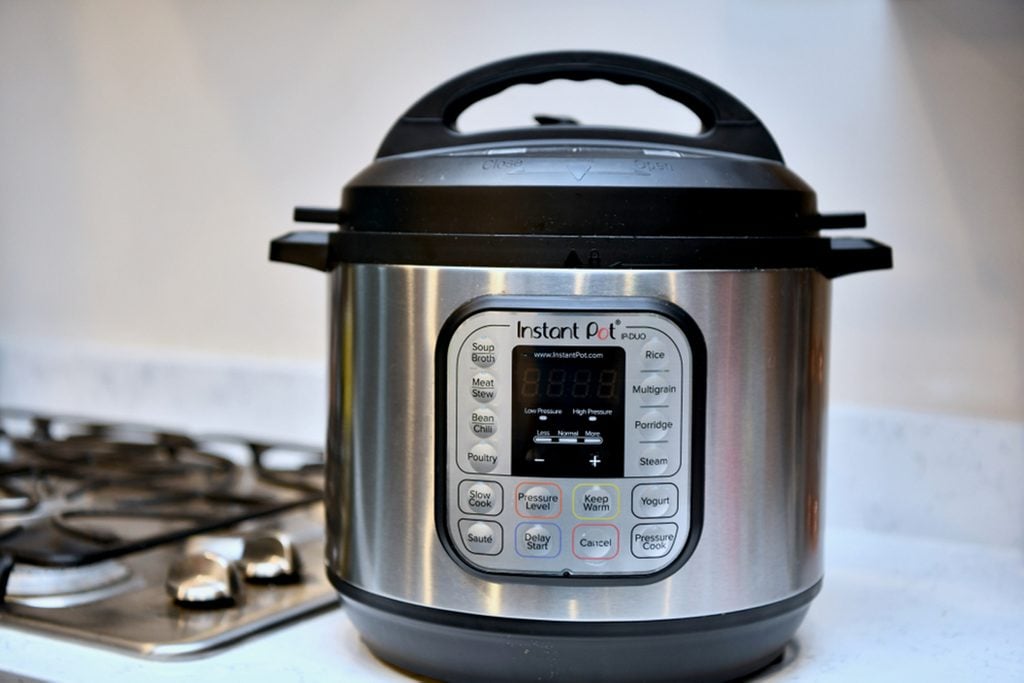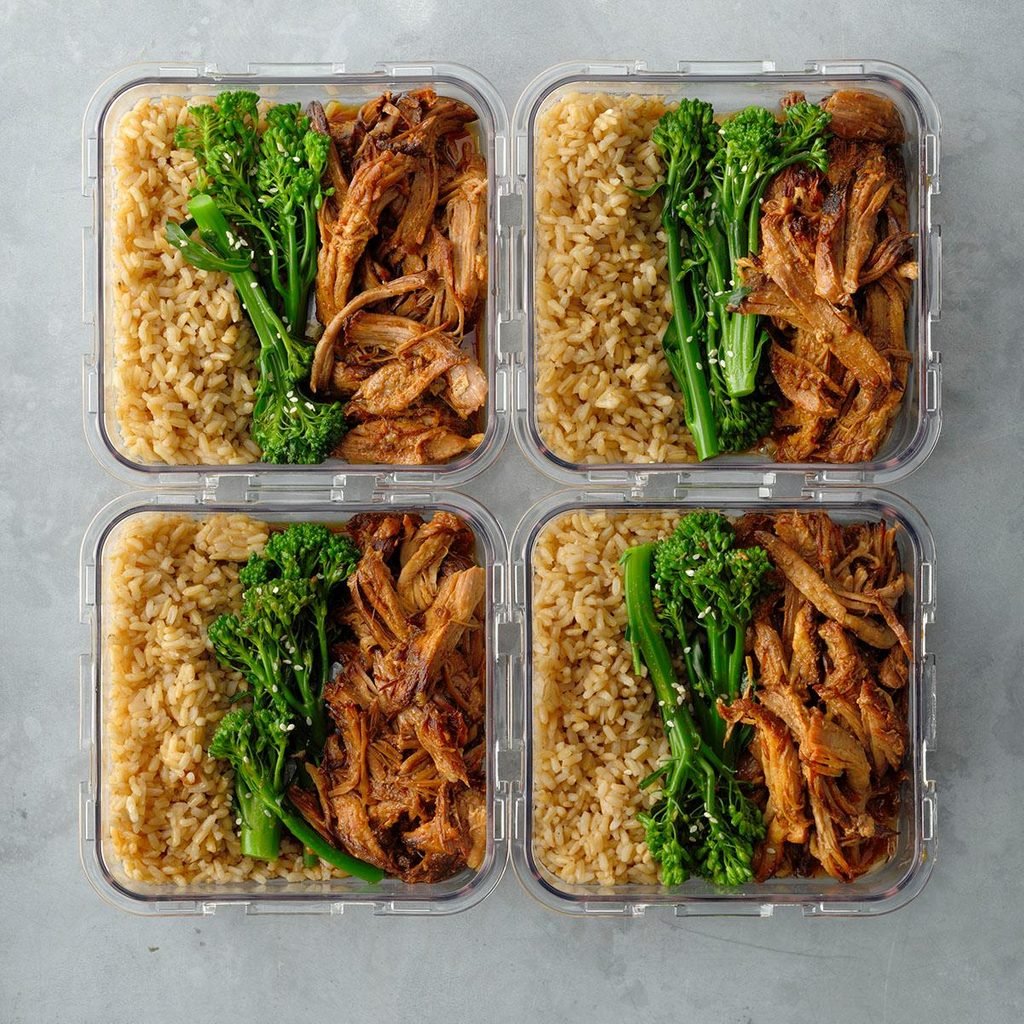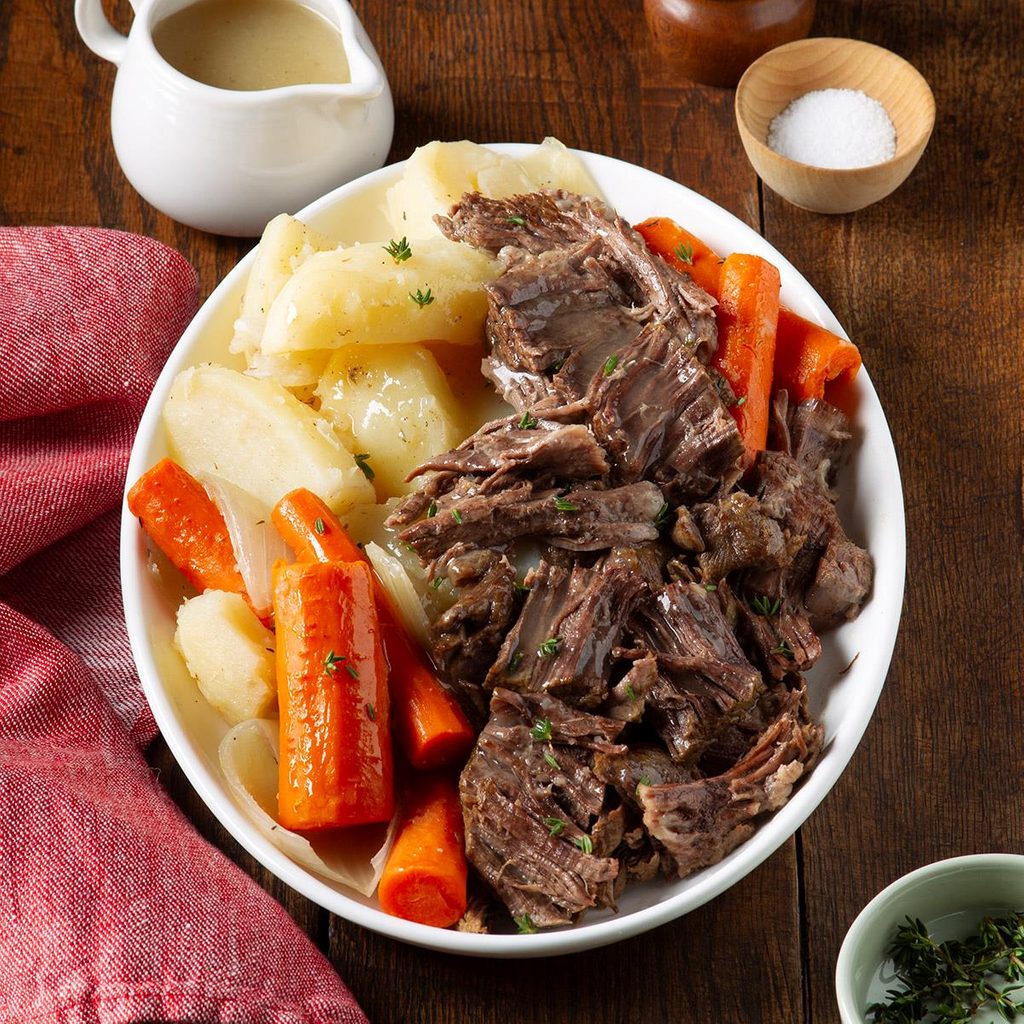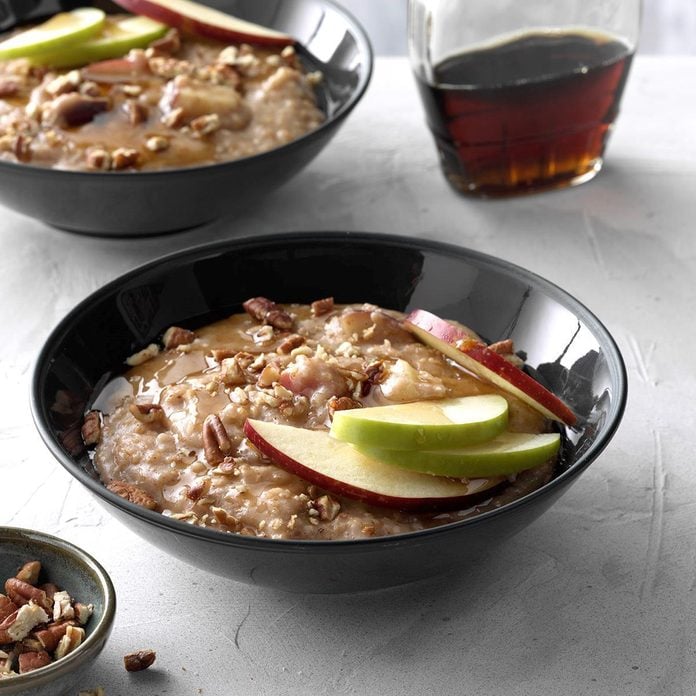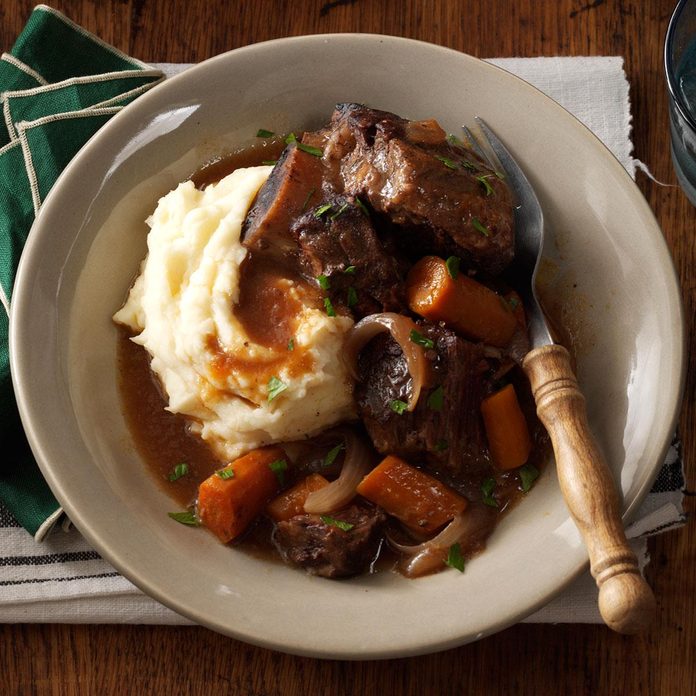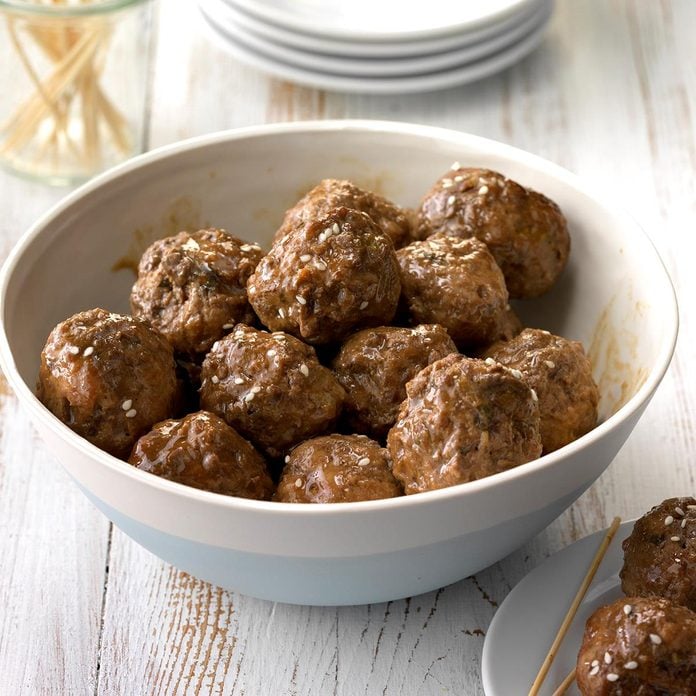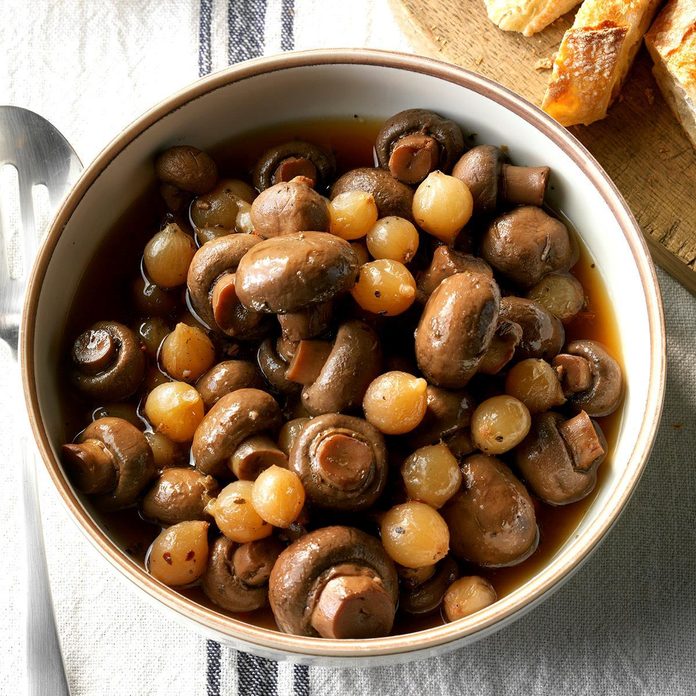 Taste of Home
Taste of Home
One of my all-time favorite German dishes is sauerbraten, but I don't love that it normally takes five to 10 days to make. Using an electric pressure cooker, I think I've captured that same distinctive flavor in less than two hours. —James Schend, Deputy Editor, Taste of Home
Are you an Instant Pot newbie? Check out our Instant Pot guide
to decode all the controls and buttons.
Get Recipe
Instant Pot Tequila Salsa ChickenI had this dish at a local Mexican restaurant when celebrating a friend's birthday. I fell in love with the spicy, smoky flavor from the tequila and decided to try Instant Pot salsa chicken at home. Boy, was it a success! It's also great stuffed into flour tortillas or for making nachos. —Trisha Kruse, Eagle, Idaho
Don't miss our
best instant pot recipes.
Instant Pot Buffalo Wing PotatoesI was getting tired of mashed potatoes and baked spuds, so I decided to create something new. This potluck-ready recipe is an easy and delicious twist on the usual potato dish. —Summer Feaker, Ankeny, Iowa
Instant Pot Clam ChowderClam chowder is especially tasty when it's served with a sprinkle of fresh thyme, bacon crumbles and crispy oyster crackers on top. If you like your chowder on the thick side, add another tablespoon of flour after it is done in the pressure cooker. —
Taste of Home Test Kitchen
Instant Pot Sesame ChickenYour family will love the flavorful sauce in this Instant Pot sesame chicken. And you'll love how quick and easy it is for a weeknight dinner! If you serve gluten-free meals, use tamari instead of soy sauce. — Karen Kelly, Germantown, Maryland
Instant Pot Lentil StewThis tasty vegetarian stew lets you take a break from meat. Adding the cream at the end gives it a lovely smoother texture. —Michelle Collins, Suffolk Virginia
Instant Pot Fabulous FajitasWhen friends call to ask for new recipes to try, suggest these tasty fajitas. Top as you like to add healthy color and extra flavor. —
Taste of Home Test Kitchen
Instant Pot Smoked Salmon PastaI love making one-pot pastas in my pressure cooker. Every noodle soaks up the flavors of the delicious ingredients. I tried a version with some leftover smoked fish and fresh dill, and boom—this smoked salmon pasta was born. It's now a staple in our house because the dish is on the table in a half hour and the kids love it! —Shannon Dobos, Calgary, Alberta
Instant Pot Cauliflower Tikka MasalaI'm a vegetarian and I always find it challenging to find new instapot recipes. This cauliflower tikka masala is my easy take on the original. It's made healthy by the use of an air fryer and pressure cooker. —Garima Arora, Charlotte, North Carolina
Instant Pot Char Siu PorkI based this juicy pork on Asian influence in Hawaii. It's tasty as is, in a bun or over rice. Use leftovers with fried rice, ramen and salads. —Karen Naihe, Kamuela, Hawaii
Instant Pot Mesquite RibsWhen we're missing the taste of grilled food during winter, these tangy ribs give us that same smoky barbecue flavor we love. They're so simple, and they're fall-off-the-bone delicious too! —Sue Evans, Marquette, Michigan
Try these must-have
Instant Pot accessories every cook should own.
Instant Pot Chicken BrothThere’s nothing better or more satisfying than making your own chicken broth. You
can control the amount of seasoning and salt, so you can customize it for whatever recipes you’re using it in. —Taste of Home Test Kitchen, Milwaukee, Wisconsin
Find more easy ideas for
what to cook in your Instant Pot.
Instant Pot Spicy Cowboy BeansThese spicy cowboy beans are a perfect contribution to a potluck buffet any time of year. Instead of needing hours on the stove, they cook quickly in the instapot and there's no need to pre-soak the beans. —Joan Hallford, North Richland Hills, Texas
Instant Pot Chicken PaprikaI truly appreciate the speed of the pressure cooker. We use it often to make these tender paprika chicken breasts with a sauce that gets its richness from sour cream. —Holly Ottum, Racine, Wisconsin
Instant Pot Balsamic Pork TenderloinThis instapot pork tenderloin with sweet brown sugar and balsamic glaze will become a go-to dinner your whole family will love. It's perfect for busy weeknights, but also special enough for company. —Karen Kelly, Germantown, Maryland
Instant Pot Cajun-Style Beans and SausageBeans and rice make the perfect meal because they're well-balanced, an excellent source of protein, and easy to prepare. Sausage adds full flavor to the recipe, and traditional pork sausage lovers won't even notice the switch to chicken sausage. —Robin Haas, Cranston, Rhode Island
Psst! We've simplified the
Instant Pot manual, just for you!
Instant Pot Orange Chipotle ChickenThe citrus in this delicious chicken dish keeps things fresh and lively. We're big on spice in our house, so sometimes I use two chipotle peppers. —Deborah Biggs, Omaha, Nebraska
Don't forget to check out these
healthy Instant Pot recipes.
Instant Pot Philly Cheesesteak SandwichesThese sandwiches are melt-in-your-mouth delicious! Everybody loves a good cheesesteak smothered with onions and peppers, then topped with cheese. —Kimberly Wallace, Dennison, Ohio
Instant Pot Chicken and Bacon White ChiliI made a twist on my favorite white chicken chili and used my pressure cooker, which made it very quick and easy. I like to serve it with avocado, cilantro and onions. —Teri Lee Rasey, Cadillac, Michigan
Instant Pot Presto PeppersTraditional stuffed peppers get a southwestern twist! The filling also makes a delicious meat loaf that we even like cold as a sandwich with Mexican-blend or cheddar cheese, mayo and salsa. —Traci K Wynne, Denver, Pennsylvania
Find more
Instant Pot ground beef recipes.
Instant Pot Beef StewI like to serve this twist on traditional stew with fresh rolls or crusty bread. The roast and vegetables cook quickly and make a comforting meal. My family loves this unique pressure-cooker beef stew. —Joanne Wright, Niles, Michigan
Instant Pot Pizza Quinoa CasseroleIf you like pizza night, give this healthy quinoa casserole a try! It's a fun way to sneak in a healthy meal packed with protein and veggies. —Julie Peterson, Crofton, Maryland
Instant Pot Apple Steel-Cut OatmealI absolutely love this one-dish oatmeal. The steel-cut oats have so much flavor and texture. My family loves to sprinkle toasted pecans on top. —Angela Lively, Conroe, Texas
Instant Pot Corn ChowderEnjoy this chowder’s rich, slow-simmered flavor in record time by using an Instant Pot. Corn chowder is a classic staple, with its hearty flavors of creamy sweet corn, bacon crumbles, shredded cheddar cheese and chopped parsley. —Taste of Home Test Kitchen, Milwaukee, Wisconsin
Instant Pot Stuffed PeppersHere's a good-for-you dinner that's also a meal-in-one classic. Add a salad and, in just moments, call everyone to the table. —Michelle Gurnsey, Lincoln, Nebraska
Instant Pot Chicken Tortilla SoupYour family will thank you for this pressure cooker chicken tortilla soup! Leftovers taste amazing the next day. —Karen Kelly, Germantown, Maryland
Instant Pot Curried Chicken Meatball WrapsMy strategy to get picky kids to eat healthy: Let everyone assemble their dinner at the table. We love these easy meatball wraps topped with crunchy veggies and peanuts, sweet raisins and a creamy dollop of yogurt. —Jennifer Beckman, Falls Church, Virginia
Instant Pot Garlic-Dill Deviled EggsEaster isn't complete without deviled eggs. I like to experiment with my recipes, and was pleasantly surprised with how the fresh dill really perked up the flavor of these irresistible appetizers. —Kami Horch, Frankfort, Maine
Learn how to make
Instant Pot hard-boiled eggs with our step-by-step guide.
Instant Pot Spicy Lime ChickenThis tender chicken with light lime flavor is a natural filling for tacos, but my son Austin also loves it spooned over cooked rice and sprinkled with his favorite taco toppings. —Christine Hair, Odessa, Florida
Instant Pot Beef TipsThese beef tips remind me of a childhood favorite. I cook them with mushrooms and serve them over brown rice, noodles or mashed potatoes. —Amy Lents, Grand Forks, North Dakota
Check out these
slow cooker beef recipes.
Instant Pot Lemon Chicken with BasilNo matter when I eat it, this tangy chicken dish always reminds me of summer meals with friends and family. The recipe produces a lot of lovely sauce; serve it as is or spoon it over some lightly herbed couscous. —Deborah Posey, Virginia Beach, Virginia
Instant Pot Italian Turkey Breast
Instant Pot Chicken Chop SueyIf you’re in for a busy evening, here’s a wonderful way to ensure you can still have a healthful supper. It’s tasty, traditional—and easy, too. —Melody Littlewood, Royal City, Washington
Instant Pot Red Beans and RiceMy family loves New Orleans–style cooking, so I make this dish often. I appreciate how simple it is, and the smoky ham flavor is scrumptious. —Celinda Dahlgren, Napa, California
Instant Pot Pork ChopsEveryone will enjoy these fork-tender pork chops with a creamy, light gravy. Serve with a green vegetable, mashed potatoes or a salad. —Sue Bingham, Madisonville, Tennessee
Instant Pot Boeuf BourguignonI've wanted to make beef Burgundy ever since I got one of Julia Child's cookbooks, but I wanted to find a way to fix it in a pressure cooker. My version of the popular beef stew is still rich, hearty and delicious, but without the need to watch on the stovetop or in the oven.—Crystal Jo Bruns, Iliff, Colorado
Instant Pot Mexican Stuffed PeppersThese pressure-cooker stuffed peppers get a southwestern twist! The filling also makes a delicious meat loaf that we like cold as a sandwich with cheddar cheese, mayo and salsa. —Traci Wynne, Denver, Pennsylvania
Instant Pot Chicken CacciatoreMy husband and I own and operate a busy farm. There are days when there's just no time left for cooking! It's really nice to be able to come into the house at night and have dinner ready in just a few minutes. —Aggie Arnold-Norman, Liberty, Pennsylvania
Find more
chicken recipes for your Instant Pot.
Instant Pot Teriyaki Pork RoastI'm always looking for no-fuss recipes, so I was thrilled to find this one. The tender teriyaki pork has become a family favorite. —Roxanne Hulsey, Gainesville, Georgia
Instant Pot Pork Chops and Acorn Squash
Instant Pot Pork Tacos with Mango SalsaI've made quite a few tacos in my day, but you can't beat the tender filling made in a pressure cooker. These are by far the best pork tacos we've had—and we've tried plenty. Make the mango salsa from scratch if you have time! —Amber Massey, Argyle, Texas
Instant Pot Mushroom Pork RagoutSavory, quickly made pork is luscious served in a delightful tomato gravy over noodles. It’s a nice change from regular pork roast. I serve it with broccoli or green beans on the side. —Connie McDowell, Greenwood, Delaware.
Instant Pot Spicy Pork and Squash RaguThis recipe is a marvelously spicy combo perfect for cooler fall weather—so satisfying after a day spent outdoors. —Monica Osterhaus, Paducah, Kentucky
Instant Pot Sweet Onion and Cherry Pork Chops
Instant Pot Pork and Apple CurryHere's a gentle curry dish that's won't overwhelm more delicate palates. For fun, try varying the garnish—add a few chopped peanuts or a little chutney. —Nancy Reck, Mill Valley, California
Instant Pot Autumn Apple ChickenFill the whole house with the aroma of chicken with apples and barbecue sauce. This is a meal you won’t want to wait to enjoy. —Caitlyn Hauser, Brookline, New Hampshire
Instant Pot Herbed Turkey Breasts
Instant Pot Chicken with Raisins and CapersCapers, golden raisins and fresh basil give this dish a sweetly savory flavor. And what's even better than that? The kids love it! —Nadine Mesch, Mount Healthy, Ohio
Instant Pot Indian-Style Chicken and VegetablesThis easy Indian-influenced dish is one just about everyone will love. Feel free to add more or less tikka masala sauce according to your taste. —Erica Polly, Sun Prairie, Wisconsin
Instant Pot Red Pepper ChickenChicken breasts are treated to black beans, red peppers and juicy tomatoes in this southwestern supper. We love it served with rice cooked in chicken broth—and it would also make a great filling for tacos or burritos. —Piper Spiwak, Vienna, Virginia
Instant Pot Chili con CarneAlthough multicookers can’t replace every tool in the kitchen, they sure are coming close. Chili con carne is one of our favorite dishes to re-create in them. This cooks up fast but tastes like it simmered all day! —Taste of Home Test Kitchen, Milwaukee, Wisconsin
Instant Pot Mushroom Chicken and PeasSome amazing fresh mushrooms at our local farmers market inspired this dish. Start with the best ingredients and you can’t go wrong. —Jenn Tidwell, Fair Oaks, California
Instant Pot Lemon Red PotatoesButter, lemon juice, parsley and chives enhance this simple side dish. I usually prepare these potatoes when I'm having company. Since they cook in the pressure cooker, there's plenty of room on the stove for other dishes. —Tara Branham, Austin, Texas
Instant Pot Flan in a JarSpoil yourself or the people you love with these delightful portable custards—a cute and fun take on the
Mexican dessert classic. Tuck a jar into your lunchbox for a sweet treat. —Megumi Garcia, Madison, Wisconsin
Instant Pot Beef Brisket in BeerOne bite of this super tender brisket and your family will be hooked! The rich gravy is perfect for spooning over a side of creamy mashed potatoes. —Eunice Stoen, Decorah, Iowa
Instant Pot Ground Beef StroganoffMy mother gave me this recipe 40 years ago. It's a wonderfully tasty dish that's perfect for a pressure cooker. —Sue Mims, Macclenny, Florida
Instant Pot Chicken Tikka MasalaThe flavors of this Indian-style entree keep me coming back for more. The dish isn’t
fancy, and it’s simply spiced—but it’s simply amazing. —Jaclyn Bell, Logan, Utah
Instant Pot Very Vanilla CheesecakeCinnamon and vanilla give this cheesecake so much flavor, and making it in the pressure cooker creates a silky, smooth texture that's hard to resist. —Krista Lanphier, Milwaukee, Wisconsin
Instant Pot Short RibsThese tender pressure-cooker short ribs explode with flavor, and they're a quick and easy alternative to traditionally braised short ribs. Serve with egg noodles, rice or polenta. .—Rebekah Beyer, Sabetha, Kansas
Instant Pot White Bean Chicken ChiliMy sister shared this chili recipe with me. The jalapeno adds just enough heat to notice but not too much for my children. —Kristine Bowles, Albuquerque, New Mexico
Instant Pot Beef CarnitasI came up with this pressure-cooker beef carnitas recipe while cleaning out my refrigerator, and trying to figure out what I could do with a pot roast that had been in the freezer. I LOVE how easy this is. —Ann Piscitelli, Nokomis, Florida
Instant Pot Turkey with Berry Compote
Instant Pot Red Clam SauceThis recipe tastes as if you've been working on it all day. What a classy way to jazz up pasta sauce! —JoAnn Brown, LaTrobe, Pennsylvania
Instant Pot Orange Spice CarrotsTo get my son to eat veggies, I mix and match flavors and spices. My carrots with orange and cinnamon won him over. —Christina Addison, Blanchester, Ohio
Instant Pot Winter Fruit CompoteYou can make this colorful and easy fruit relish up to a week in advance. It's an outstanding accompaniment to turkey, chicken or pork throughout the holiday season. —Esther Chesney , Carthage, Missouri
Instant Pot Frittata Provencal
Instant Pot Mediterranean Chicken OrzoOrzo pasta with chicken, olives and herbes de Provence has the bright flavors of Mediterranean cuisine. Here’s a bonus: Leftovers reheat well. —Thomas Faglon, Somerset, New Jersey
Instant Pot Easy Pork PosoleLooking for a meal in a bowl? Sit down to a Mexican classic full of cubed pork, sliced sausage. hominy and more. It all goes into the pressure cooker, so you can come home at night and dinner is ready in a flash. —Greg Fontenot, The Woodlands, TX
Instant Pot Molten Mocha CakeWhen I first made my decadent chocolate cake, my husband's and daughter's expressions said it all. She says it's one of her "most favorites." Later, I took one of these to our next-door neighbors. Their teenage son, who answered the door, ate the whole thing without telling anyone else about it! —Aimee Fortney, Fairview, Tennessee
Instant Pot Buffalo Shrimp Mac & CheeseFor a rich, creamy and slightly spicy shrimp and pasta recipe, you can't beat this crowd-pleasing dish. It's a nice new twist on popular Buffalo chicken dishes.—Robin Haas, Cranston, Rhode Island
Instant Pot Cuban Pulled Pork SandwichesI lived in Florida for a while and loved the pork served there, so I went about making it for myself! The flavorful meat makes amazing Cuban sandwiches, but you can use it in traditional pulled pork sandwiches and tacos, too. —Lacie Griffin, Austin, Texas
Instant Pot Mini Teriyaki Turkey SandwichesPreparing the pulled turkey in a delicious teriyaki sauce for these snack-size sandwiches is a breeze using a pressure cooker. Serving them on lightly-toasted sweet dinner rolls is a finishing touch.—Amanda Hoop, Seaman, Ohio
Instant Pot Truly Tasty Turnip GreensThese savory greens are a hit at every church dinner. Adjust the seasonings as you please to make the recipe your own. .—Amy Inman, Hiddenite, North Carolina
Instant Pot Pot Roast HashI love to cook a Sunday-style pot roast for weeknights. Make it into pot roast hash for any day of the week. —Gina Jackson, Ogdensburg, New York
Instant Pot Carrot Cake OatmealThis warm breakfast cereal made in the pressure cooker is a great way to add some veggies in the morning and keep a healthy diet! For extra crunch, I garnish individual servings with ground walnuts or pecans.—Debbie Kain, Colorado Springs, Colorado
Instant Pot Herbed Chicken and ShrimpTender chicken and shrimp make a flavorful combination that's easy to prepare, yet elegant enough to serve at a dinner party. While I clean the house, it practically cooks itself. I serve it over hot cooked rice with crusty bread and a green salad. —Diana Knight
Reno, Nevada
Instant Pot Celebration Brussels SproutsThis recipe hits all the flavor points and makes a fantastic side throughout the year. Plus, you've got to love a dish that requires minimal effort and doesn't take up oven space. You can always omit the bacon if you need a vegetarian option. —Lauren McAnelly, Des Moines, Iowa
Instant Pot Thai Coconut BeefMy husband and I love Thai food, but going out on weeknights can be challenging with busy schedules. I wanted to create a Thai-inspired dinner that could double as an easy lunch the following day. The beef is fantastic in this dish, but chicken or pork would be equally delicious!—Ashley Lecker, Green Bay, Wisconsin
Instant Pot Cheddar Bacon Ale DipMy tangy, smoky dip won the top prize at our office party recipe contest. Use whatever beer you like, but steer clear of dark varieties. —Ashley Lecker, Green Bay, Wisconsin
Instant Pot Lentil Pumpkin SoupPlenty of herbs and spices brighten up my hearty pumpkin soup. It?s just the thing we need on nippy days and nights. —Laura Magee, Houlton, WI
Instant Pot Cranberry Hot WingsCranberry wings remind me of all the wonderful celebrations and parties we've had through the years. My daughter?s friends can?t get enough of them. —Noreen Danek, Cromwell, CT
Instant Pot Hoisin MeatballsI love the start of fall because that means it's football season! Meatballs are filling and hearty and great for a tailgate. I served this for the first time at my favorite team's home opener. My best friend, who hates meatballs, couldn't get enough of them! I created a meatball convert! Woo-hoo! If you are serving children and prefer not to add the wine, substitute beef broth instead.—Lisa de Perio, Dallas, Texas
Instant Pot Cherry & Spice Rice PuddingI live in Traverse City, which calls itself the cherry capital of the world. What better way to celebrate our wonderful orchards than by using plump, tart dried cherries in my favorite desserts? This pressure-cooked rice pudding recipe always turns out wonderful. —Deb Perry, Traverse City, Michigan
Instant Pot Beer-Braised Pulled HamTo jazz up leftover ham, I cooked it with a beer sauce. Buns loaded with ham, pickles and mustard are irresistible. —Ann Sheehy, Lawrence, Massachusetts
Instant Pot Cranberry Apple Red CabbageWhen I was looking for something new, I started playing with flavors and came up with this very tasty dish. My German grandmother would be impressed, I think! The colorful side is just right with pork. —Ann Sheehy, Lawrence, Massachusetts
Instant Pot Potato SoupI decided to add some character to a basic potato chowder with roasted red peppers. The extra flavor gives a deliciously unique twist to an otherwise ordinary soup.—Mary Shivers, Ada, Oklahoma
Instant Pot Red Beans & RiceMy dear mother-in-law passed this simple recipe to me. With meats, beans and savory veggies, it's tasty, easy and economical, too! —Carol Simms, Madison, Mississippi
Instant Pot Apple Balsamic ChickenI just love the sweet and tart flavor that balsamic vinegar gives to this easy dish. After cooking in the pressure cooker for just a few minutes, the chicken thighs are tender and flavorful. —Juli Snaer, Enid, Oklahoma
Instant Pot Hearty Pork & Black Bean NachosMy husband and I are both graduate students right now, so we don't have a lot of time to cook dinner. Our family loves coming home to this incredible nacho platter, and I love how easy it is to prepare. —Faith Stokes, Chickamauga, Georgia
Instant Pot Italian Sausage & Kale SoupThe first time I made this colorful soup, our home smelled wonderful. We knew it was a keeper to see us through cold winter days. —Sarah Stombaugh, Chicago, Illinois
Instant Pot Osso BuccoOur beef osso buco boasts a thick, savory sauce complemented by the addition of gremolata, a chopped herb condiment made of lemon zest, garlic and parsley. —Taste of Home Test Kitchen, Milwaukee, Wisconsin
Instant Pot Marinated MushroomsHere's a terrific healthy addition to any buffet spread. Mushrooms and pearl onions seasoned with herbs, balsamic and red wine are terrific on their own or alongside a tenderloin roast. —Courtney Wilson, Fresno, California
Instant Pot Tuna Noodle CasseroleWe tweaked this family-friendly classic tuna casserole to work for the pressure cooker. Go for easy, wholesome and totally homemade!—Taste of Home Test Kitchen, Milwaukee, Wisconsin
Instant Pot Memphis-Style RibsAfter my dad and I had dinner at the legendary Rendezvous restaurant, I was inspired to create my own version of tasty dry-rub Memphis ribs. Smoked paprika in the rub mimics the flavor the ribs would get from grilling over hot coals. —Matthew Hass, Franklin, Wisconsin
Instant Pot Sicilian Meat SaucePeople have told me this is better than the gravy their Sicilian grandmothers used to make. But don't tell the older generation that! —Emory Doty, Jasper, Georgia
Instant Pot Apple-Cranberry GrainsThese assorted pressure-cooker grains are perfect together. A hearty breakfast is ready fast in the morning, making this healthy recipe a favorite in my home. —Sherisse Dawe, Black Diamond, Alberta, Canada
Instant Pot Maple French ToastMy family and friends all love it when I make this delicious French toast in the morning. It's so delicious and easy! —Cindy Steffen, Cedarburg, Wisconsin
Instant Pot Rigatoni with Sausage & PeasWith a tomatoey meat sauce and tangy goat cheese, this weeknight wonder is my version of comfort food. You want to have bowl after bowl. —Lizzie Munro, Brooklyn, New York
Instant Pot Sicilian Chicken BogChicken Bog is a South Carolina tradition with lots of variations—think herbs, spices and fresh veggies—but the standard ingredients remain sausage, chicken and rice. This pressure-cooked rendition is a simple take on the classic. — Anna Hanson, Spanish Fork, Utah
